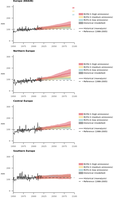
The extreme precipitation total index represents the total precipitation on all days with heavy precipitation, defined as exceeding the 99th percentile of daily precipitation over the reference period. Therefore, it accounts for both the frequency and magnitude of unusual precipitation events identified with respect to the baseline conditions. Other implementations of this index may use a different percentile (e.g., 95th) depending on the level of rarity of events to be considered.

The maximum consecutive five-day precipitation index accounts for the greatest precipitation total over five consecutive days in a year.

Total precipitation represents the total amount of precipitation over a given period (e.g., whole year or a season).

The frost days index is defined as the number of days in a year with a daily minimum temperature below 0°C. Variations of this index limit the counting of frost occurrences to particular seasons (e.g., the growing season or the spring months). A closely related index is ‘ice days’, which uses daily maximum instead of minimum temperature.

The warmest three-day mean temperature is the highest daily mean temperature in a year averaged over a three-day window. In variations of this index, the length of the time window over which the moving average of temperature is computed could vary depending on the specific application.
Document Actions
Share with others